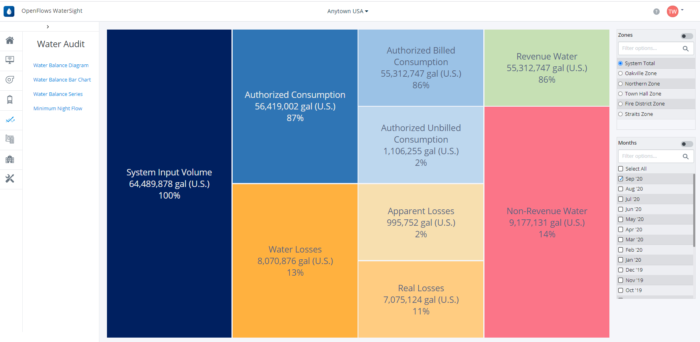In Bentley’s OpenFlow WaterSight software, we can automatically take water utility production and billing data and generate a water balance diagram based on AWWA M-36 for any time period or area (e.g. DMA, system wide). One of the issues that comes up in developing the water balance is how to distinguish apparent and real losses, given that only total water loss can be known accurately.
Distinguish apparent vs real loss
We need to develop a method to divide total loss into apparent and real. Hard data on this divide can’t be determined. Some estimation is required. We provide two methods, each with its own strengths and weaknesses. We’d like to get some feedback.
Method A:
Usually it is possible to make a reasonable estimate of apparent loss based on the tested accuracy of customer meters plus an allowance for unauthorized consumption and systematic data handling errors as presented in M-36. This volume can be divided by the total loss to give a fraction of the total loss that is apparent.
A = apparent loss/total loss
The fraction that is real loss can then be given by
R = 1 – A
Therefore
Apparent loss = A x total loss
Real loss = R x total loss
The values of A and R can be calculated system wide or by area. The value can be updated as new information arrives.
Method B:
The minimum nighttime flow can be used as an upper limit of the amount of real loss because apparent loss due to unauthorized use and meter under-registration should be at a minimum in MNF, but real losses will continue. With that, real loss can be calculated as
Real loss = f MNF
The value of f is based on the fraction of minimum nighttime flow that is the real loss and is estimated by the user. (As a default value, we may use 1.) An advantage here is that MNF can be calculated every day if desired. The potential issue here is that if f is too large, the f MNF can be greater than total loss, which would result in a negative apparent loss since
Apparent loss = Total loss – f MNF
The value of f can be calculated on a small time scale and can be applied system-wide or for small areas.
We would like to get some feedback from readers on whether you would prefer to use method A or B and why. Both involve some estimation. Method A uses an estimate for apparent loss, while method B involves an estimate of f. While neither can be measured precisely, both are reasonable quantities to estimate based on other observations. If you have an opinion, just email me at tom.walski@bentley.com with your thoughts.
To get more in-depth information on this topic see:
AWWA, 2016, “Water Audits and Loss Control Programs, AWWA M-36, Denver, Col.
If you want to contact me (Tom), you can email tom.walski@bentley.com.
Want to learn more from our resident water and wastewater expert? Join the Dr. Tom Walski Newsletter today!











